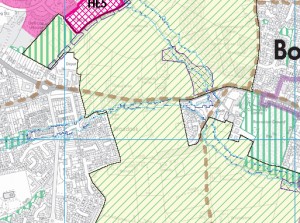What is a gap? It could of course be that chasm between the train and the platform, or it could be a year’s worth of backpacking taken to separate the eras of study and work. For me, lately my context for the word ‘gap’ seems to have been one relating to Planning policy.
Strategic gaps and Local gaps have been around for a while. Local Planning Authorities (LPA’s) have defined them in their Local Plans, and use them as an argument against development. I’m guessing that most readers of this blog will have a sense that the Planning system is currently in a state of some turmoil. Many LPAs’ are still relying on ‘saved policies’ of Local Plans which were written years ago, and are largely considered to be out-dated, and un-safe for application in the context of today’s planning and development pressures. In particular, we know that the country needs more homes, and to that end LPA’s are tasked with setting targets for delivering housing developments. Bringing those targets to a level which applies to the reality of today and the years to come often creates a disjuncture with the “saved policies’ of outdated Local Plans.
This disjuncture presents itself as an opportunity for developers to apply for Planning consent, even when their proposals are against policy. When the policy is questionable in relation to the reality of today’s targets to meet housing need, developers are willing to force the validity of those policies to be questioned. Perhaps this is more often than not where LPA’s have at some time in the past designated a ‘gap’.
If the validity of a gap designation is to be challenged, it is important to first understand what it is….
Planning policy in relation to gaps place a presumption against development. But then so too do policies applicable to development outside the settlement boundary. What’s the difference? It seems that a gap is very similar to the way the planning system considers countryside. It’s like countryside – with attitude!
Planning guidance makes it clear that a gap designation is about the prevention settlement coalescence. Coalescence means the merging of settlement mass, so in a sense, you could consider a gap designation to be the antithesis of settlement massing and pattern.

Planning guidance also makes it is clear that a gap designation is not a reflection on the quality of a landscape. It is in no way comparable to ‘National Parks’, ‘Areas of Outstanding Natural Beauty’, or perhaps more appropriately at the local scale ‘Areas of Great Landscape Value’ (or equivalent terms used by individual LPA’s). Nor is it a ‘Green-belt’, though the 2 things come from similar principles (but that’s a story for another time).
A gap is nevertheless a relevant consideration in a Landscape and Visual Impact Assessment as a constituent part of what makes Landscape Character – in the same way as a Conservation Area (a Heritage Designation) or a Site for Importance in Nature Conservation (an Ecological designation). Whist the actual (physical) effects on gaps, Conservation Areas or SINCs can be assessed by consultants in the relevant discipline, the visual or perceived effects on those designations are inherent in the assessment of Landscape and Visual effects.
So, is a gap synonymous with the landscape? Well, in part. It’s not a landscape designation, and the most apparent issue is to do with Strategic Planning, but – as is so often the case – the way we see and perceive the world around us only becomes tangible as part of a broad tapestry of landscape.
Evidently perceptions are an important thing. Whether a gap is synonymous with the landscape or not, it is an entity which has achieved notoriety, with literally thousands of the public making their feelings known by displaying the word ‘Gap’ on their sweaters.